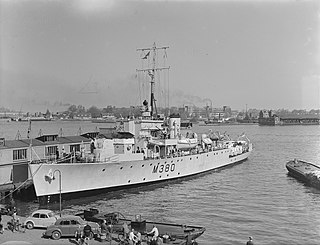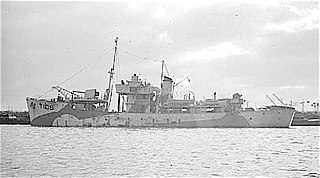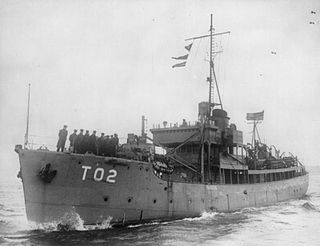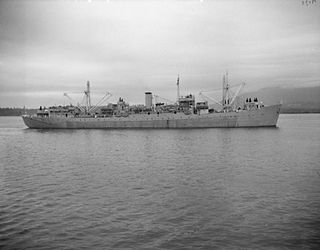
HMS Baffin was an Isles-class trawler of the Royal Navy. Constructed in Canada for the Royal Navy, the trawler was one of eight loaned to the Royal Canadian Navy during the Second World War. The vessel was mostly engaged in minesweeping duties out of Halifax, Nova Scotia. Following the war, Baffin was returned to the Royal Navy. The vessel was then sold into mercantile service. The vessel was broken up in 1983.

HMS Mariner was a reciprocating engine-powered Algerine-class minesweeper during the Second World War. Laid down as HMCS Kincardine for the Royal Canadian Navy she was transferred on completion to the Royal Navy as HMS Mariner. She survived the war and was sold to Myanmar in 1958 as Yang Myo Aung.

The Bangor-class minesweepers were a class of warships operated by the Royal Navy (RN), Royal Canadian Navy (RCN), Imperial Japanese Navy (IJN), and Royal Indian Navy (RIN) during the Second World War.
The Cape class consists of two escort maintenance ships of the Royal Canadian Navy (RCN). The ships were built in Canada as Beachy Head-class maintenance ships for the Royal Navy, but were acquired by Canada in 1952. They were commissioned into the RCN in 1959 as HMCS Cape Breton and HMCS Cape Scott. Cape Scott served on the east coast until 1972, after which the ship became a stationary repair vessel at Halifax, Nova Scotia until 1975. The vessel was broken up in 1978. Cape Breton served initially as a school ship on the east coast before transferring to the west coast of Canada in 1959. The maintenance ship remained in service until 1964, when she was laid up at Esquimalt, British Columbia as a maintenance facility. Cape Breton remained in this service until 1993. The vessel was then sold for use as an artificial reef and sunk off the coast of British Columbia.

HMCS Cape Scott was a Cape-class maintenance ship. She was built for the Royal Navy as HMS Beachy Head in 1944. She was loaned to the Royal Netherlands Navy in 1947 as HNLMS Vulkaan and returned to the Royal Navy in 1950. She was sold to the Royal Canadian Navy in 1952 and served until 1975, used as an alongside repair depot after decommissioning.

The British Royal Navy operated large numbers of small Motor Minesweepers (MMS) during the Second World War, in two major classes: the first with 105 ft (32 m) hulls and the second with 126 ft (38 m) hulls. Intended to counter magnetic influence mines in coastal waters, they had wooden hulls.

The Dance class of World War II were armed trawlers of the Royal Navy. They were used for anti-submarine (A/S) and minesweeping work and were nearly identical to the Isles class, of which they are usually considered a subclass.
HMCyS Vijaya, named in honor of Vijaya, the first king of Sri Lanka, was an Algerine-class minesweeper of the Royal Ceylon Navy, the first warship of that navy. Vijaya had been built as HMS Flying Fish (J370) for the Royal Navy during World War II, but was given to Ceylon by the United Kingdom upon the 1951 formation of Ceylon's navy.

A danlayer was a type of vessel assigned to minesweeping flotillas during and immediately after World War II. They were usually small trawlers, fitted for the purpose of laying dans. A dan is a marker buoy which consists of a long pole moored to the seabed and fitted to float vertically, usually with a coded flag at the top.
Naval trawlers were purpose-built or requisitioned and operated by the Royal Navy (RN), mainly during World Wars I and II. Vessels built to Admiralty specifications for RN use were known as Admiralty trawlers. All trawlers operated by the RN, regardless of origin, were typically given the prefix HMT, for "His Majesty's Trawler".

HMS Ardrossan was a Bangor-class minesweepers built for the Royal Navy during the Second World War.

The Shakespearian-class trawler was a series of anti-submarine naval trawlers of the Royal Navy. Ships in the class had a displacement of 545 long tons (554 t), a top speed of 12 knots and a crew of 40 men. The trawlers were armed with a QF 12-pounder [76 mm (3.0 in)] gun, three 20 mm Oerlikon anti-aircraft guns and thirty depth charges. The class was nearly identical to the Isles-class trawlers, of which they are usually considered a subclass. Coriolanus, Horatio and Laertes were lost during the war. Othello, was transferred to Italy in 1946 and Rosalind to Kenya, also in 1946. By the end of that year, only Hamlet and Macbeth remained in service with the Royal Navy; both were sold in 1947.

The Type 139 patrol trawler was a class of vessel used as a training ship by the Federal German Navy. Both vessels in the class were originally built for the Royal Navy in 1942 as Isles-class naval trawlers.

Tree-class trawlers were a class of anti-submarine naval trawlers which served in the Royal Navy during the Second World War. They were nearly identical to the Isles-class trawlers, of which they are usually considered a subclass.
The Basset class of Admiralty trawlers was a class of trawlers built for the British Royal Navy prior to the outbreak of Second World War. The vessels were intended for use as mine-sweepers and for anti-submarine warfare, and the design was based on commercial types, adapted for naval use. The purpose of the order was to make use of specialist mercantile shipyards to provide vessels for war use by adapting commercial designs to Admiralty specifications.

HMS Albrighton was a Type III Hunt-class destroyer built for the British Royal Navy. She entered service in February 1942, first carrying out an attack on German ships in the English Channel then taking part in the Dieppe Raid, rescuing survivors from the sinking destroyer HMS Broke. Albrighton was next assigned to search for and destroy the German auxiliary cruiser Komet, then escorted a convoy to Gibraltar in prevision of the Allied landings in North Africa. Between December 1942 and April 1943, she participated in the sinking of three more Axis ships with the First Destroyer Flotilla. During the Normandy Landings in June 1944, Albrighton served as a headquarters ship, then sank two German trawlers in the weeks after the invasion. After being converted to a destroyer in early 1945, she was damaged in a collision with a Landing Ship, then was assigned to the British Eastern Fleet. However, the war ended before she was deployed and Albrighton went into reserve.
HMT Almond was a Tree-class naval trawler of the British Royal Navy. Almond was launched in 1940 and served in World War II, being sunk by a mine on 2 February 1941.

The Beachy Head-class repair ships were a class of 21 depot, maintenance and repair ships constructed for the Royal Navy during the Second World War. All of the ships in the class were constructed in Canada of which only five served in British waters during the war. Based on a modified mercantile design, five of the class were completed as merchant vessels after the war's end. Following the war, the majority were converted for mercantile use, with a further two ships ending up in service with the Royal Canadian Navy and another with the Royal Air Force.

HMS Gardenia was a Flower-class corvette that served in the Royal Navy and was built by William Simons and Company in 1940. She was named after Gardenia. Commissioned in 1940, rammed and sunk by HMS Fluellen on 9 November 1942.














